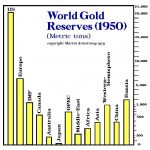Charlie Munger has a fitting analogy for investing markets; racetrack betting.
“The model I like to sort of simplify the notion of what goes on in a market for common stocks is the pari-mutuel system at the racetrack. If you stop to think about it, a pari-mutuel system is a market. Everybody goes there and bets and the odds change based on what’s bet. That’s what happens in the stock market.”
Only the very best horses are remembered. Names like Secretariat and Sea Biscuit are famous.
We have a fascination with the best. That’s because the best wins. This is just as true in investing as it is in horse racing.
It is not easy to determine the best beforehand in horse racing or in the stock market. That’s where the semi-famous disclaimer “past performance is no guarantee of future success” comes from.
This article takes a look at what the best dividend ETF available is. To determine “the best”, historical performance all dividend ETFs with over $1 billion in assets under management that were created prior to 2007 is compared.

This is backward-looking analysis. ETFs capture particular investing styles and methods. The stock selection method (presumably) does not change. In this way, we can determine what style of dividend ETF has historically outperformed – and what style has the highest likelihood of continuing to do so.
Past performance is no guarantee of future success, but it sure doesn’t hurt. I’d much rather have my money with a manager who has a historical record of outperformance (like Warren Buffett) than someone who as a historical record of losing money hand-over-fist.
In addition to performance comparisons, this article takes a look at several dividend ETF screens and lists so you can quickly find dividend ETFs worth your time and money.
It also takes a look at the pros and cons of buying dividend ETFs versus investing in individual dividend stocks. There is more to this decision than first comes to mind.
I divide the dividend ETF universe into 4 broad categories to determine performance:
The ‘Traditional’ category contains dividend ETFs that do not fall into the growth, high yield, or international categories.
The ‘Growth’ dividend ETF category contains dividend ETFs that are focused on growth or rising dividend income.
The ‘High Yield’ dividend ETF category contains dividend ETFs that invest primarily for high yield.
Finally the ‘International’ dividend ETF category contains dividend ETFs that invest primarily in international (non US) dividend stocks.
There is significant overlap in the categories. Distinctions were made as best as possible.
The Best Traditional Dividend ETF
There are 5 Dividend ETFs in the traditional category with more than $1 billion in assets under management.
AUM
0.39%
3.4%
0.28%
2.9%
0.38%
2.6%
0.70%
2.3%
0.45%
3.6%
Note: AUM stands for assets under management.
The iShares Select Dividend ETF is by far the largest of the group based on its assets under management.
The Schwab U.S. Dow Jones Dividend 100 ETF is the least expensive with an absurdly low expense ratio of just 0.07% a year.
The performance of all 5 of the traditional dividend ETFs is shown below. They are all compared against the SPDR S&P 500 ETF (SPY) to show relative performance.

Note: Returns include dividend payments
The Wisdom Tree Mid Cap Dividend Fund and the First Trust Value Line Dividend Income ETFs both outperformed the S&P 500 from 2007 through March 9th, 2016. The table below shows performance statistics.
Notes: CAGR stands for compound annual growth rate. Standard deviation is the annualized price standard deviation from 2007 through 3/9/16. Sharpe ratio uses a risk free rate of 0.7% which is the average US 3 Month T-Bill yield for the time frame of the study.
The financial ratios and metrics above show a clear winner – The First Trust Value Line Dividend Income ETF (FVD).
FVD outperformed the market by 1.4 percentage points a year while also having a lower price standard deviation of 18.8% versus 21.5% for the S&P 500. As a result FVD has a superior Sharpe ratio of 0.36 versus 0.24 for the S&P 500.
The question is why did FVD outperform?
FVD seeks to track the Value Line Dividend Index. The Value Line Dividend Index is constructed as follows:












Leave A Comment